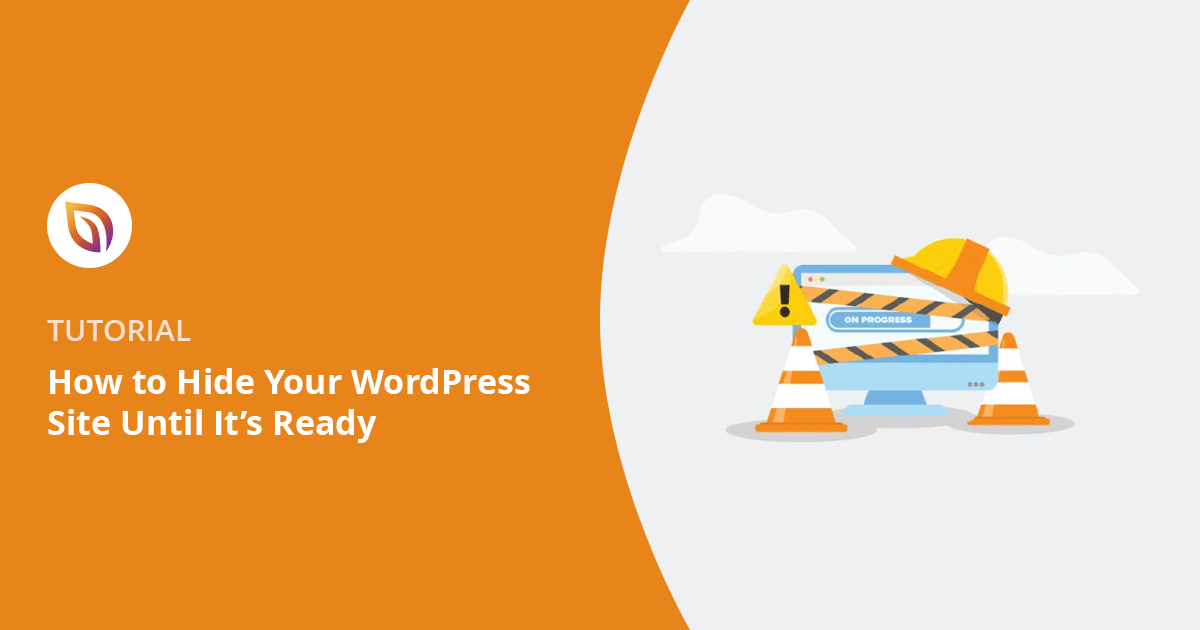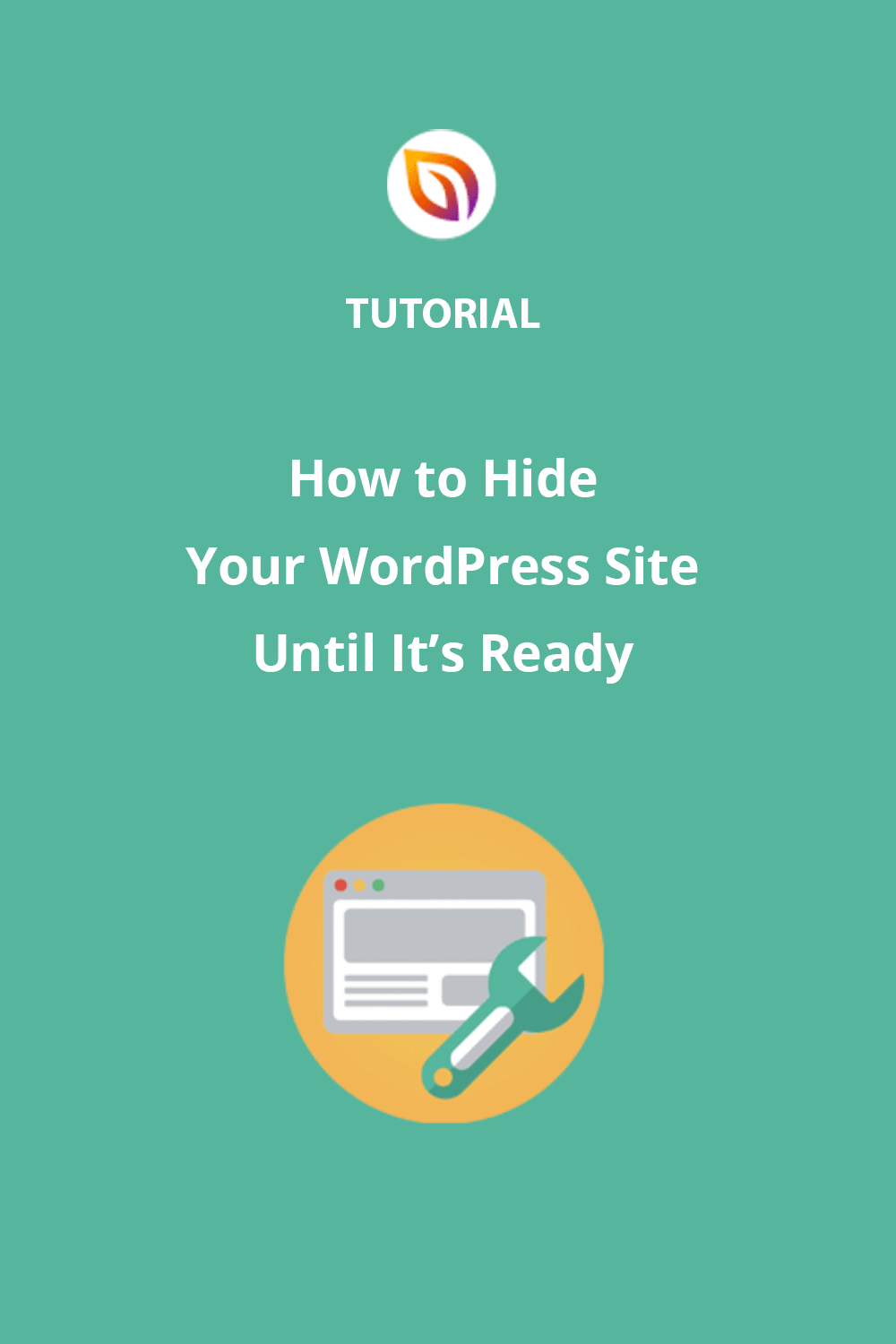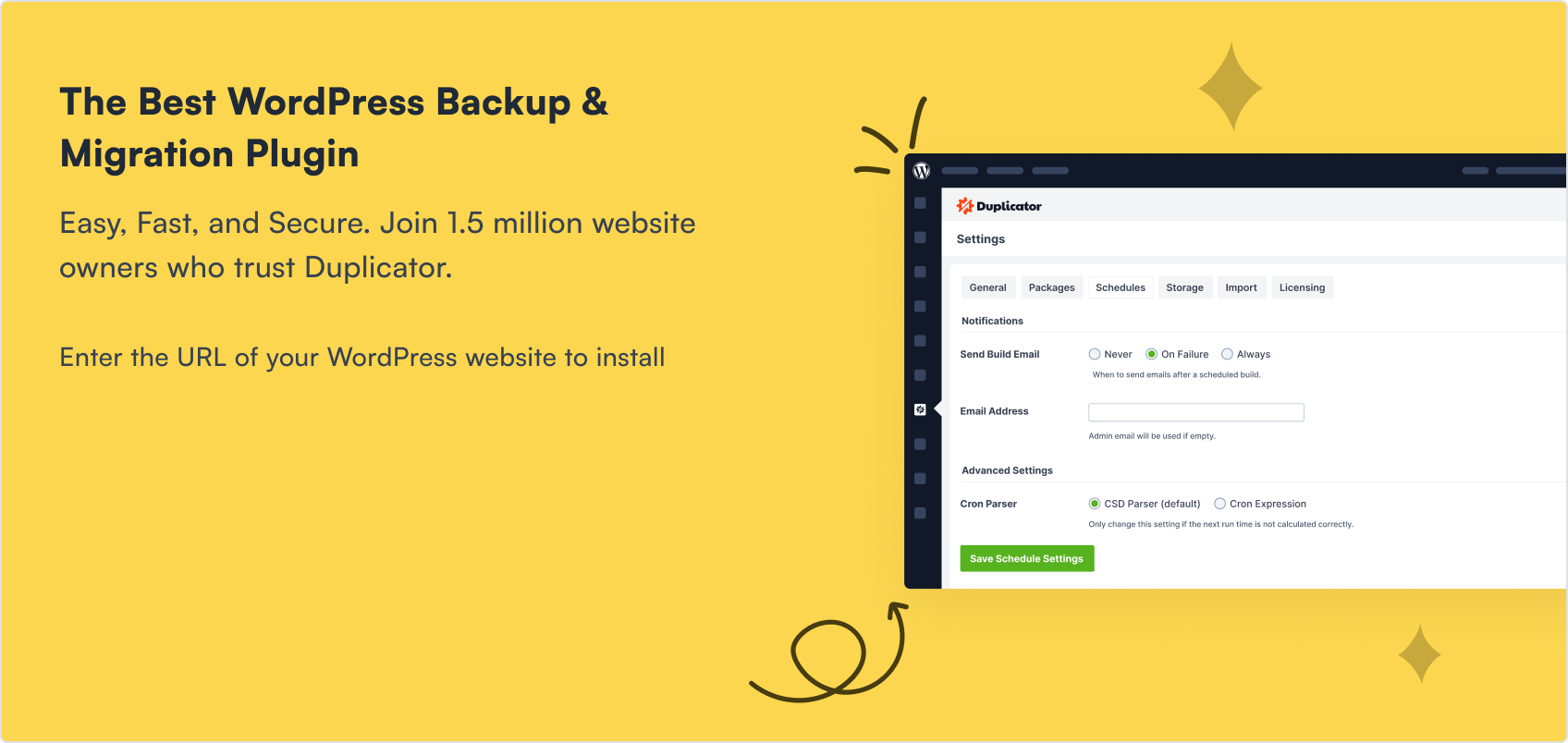A maintenance mode or coming soon page hides your WordPress site from the public while you work on it. Maintenance mode temporarily blocks access to a live site for updates, while a coming soon page shows a launch message for a new website still in development.
If you are looking for a quick answer, the easiest way to hide a WordPress site is using a maintenance mode plugin like SeedProd. Alternatively, you can use built-in password protection or modify your .htaccess file for a manual approach.
Publishing an unfinished website can hurt first impressions. In fact, 94% of users say web design affects whether they trust a brand (Stanford Web Credibility Study). By keeping your site private until it’s ready, you protect your brand and prevent visitors from seeing incomplete content.
In this guide, I’ll show you how to hide your WordPress site using a plugin like SeedProd or built-in WordPress settings. You’ll also learn how to add a coming soon page to engage visitors before your launch.
Why You Should Hide Your WordPress Site During Development
Hiding your WordPress site during development protects your brand and your SEO. When search engines crawl an unfinished site, they can index broken pages, missing content, and errors that hurt your initial rankings. According to Moz, early crawl data strongly influences how Google evaluates your site’s quality and relevance over time.
It also helps you make a better first impression. Studies show that 75% of users judge a company’s credibility based on its website design (Stanford University). Launching only when your site is polished builds trust, lowers bounce rates, and gives visitors a reason to return.
By keeping your site private until everything works properly, you control what search engines and visitors see, ensuring your launch starts on the right foot.
How to Hide a WordPress Site Until Ready
Best Option: To completely hide your WordPress site and display a custom “coming soon” or “under construction” page, use SeedProd.
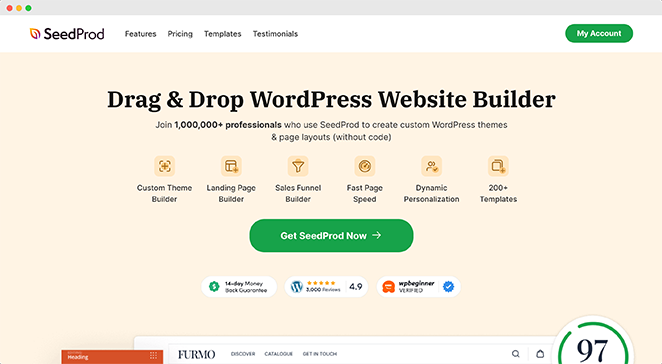
SeedProd is a WordPress website builder plugin with over 1 million active installations and a 4.9-star rating on WordPress.org. It lets you design landing pages, themes, and maintenance mode screens with a simple drag-and-drop editor, no coding required.
With SeedProd, you can hide your entire website while it’s under construction or only show certain pages. It includes two modes: Coming Soon (for new sites not yet live) and Maintenance Mode (for existing sites undergoing updates). Logged-in users can still see your full site while others view your custom page.
Next, let’s look at how to set up a maintenance or coming soon page using SeedProd.
Step 1. Set Up Your New WordPress Website
If you are creating a new website, the first step is getting reliable web hosting. I recommend Bluehost based on my experience setting up dozens of staging sites.

I found their platform very stable during testing, and it comes with a free domain name and SSL certificate. It also includes a one-click WordPress installer, which makes the initial setup much faster.
If you want a premium alternative, I also highly recommend SiteGround. I use SiteGround to host my own website, and its performance and security features are top-notch.
If you are new to this, you can follow our guide on creating a WordPress website. It walks you through the domain and hosting setup.
Once your hosting is ready, the next step is installing a maintenance mode plugin. This allows you to hide your site until you are ready to launch.
Step 2. Install the SeedProd Plugin
Next, you’ll need to get a copy of SeedProd. After creating your account, log in to your SeedProd dashboard.
Click View License Key, Details, and Downloads to find your license key and download the plugin file.
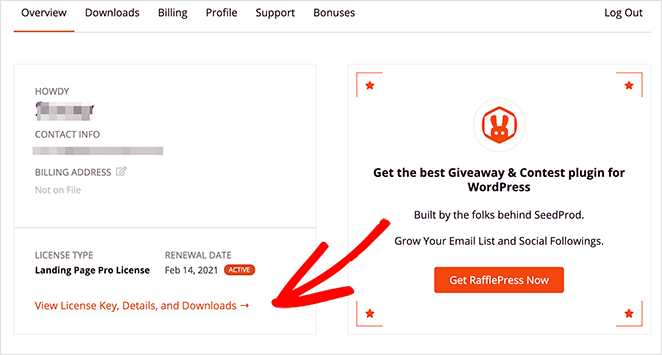
Then, copy your license key and click Download to save the plugin to your computer.
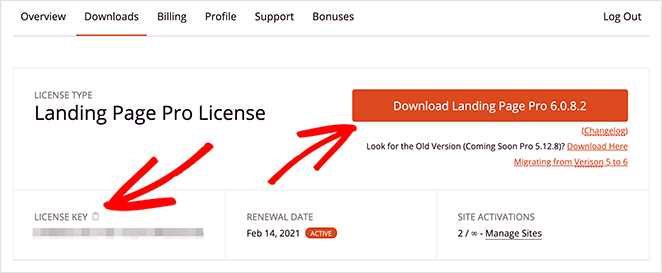
Now, install and activate the SeedProd plugin on your WordPress site. If you’re not sure how, follow this step-by-step guide to installing WordPress plugins.
Once activated, enter your license key in the box shown below and click Verify Key to unlock all features.
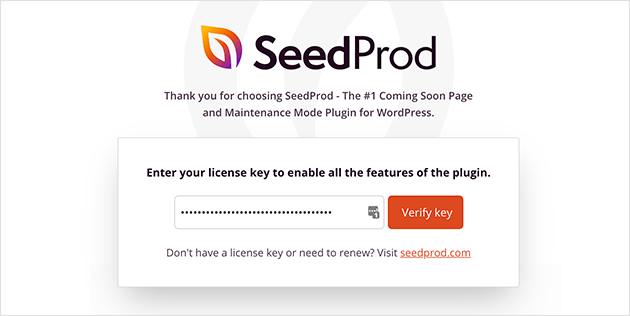
Installing SeedProd is quick and beginner-friendly, giving you full control to hide your WordPress site until it’s ready.
Step 3. Create Your Maintenance Mode Page
SeedProd makes it easy to design a custom page that people will see while your site is hidden. This helps you keep visitors interested, even though your website isn’t ready yet.
You have complete control over the design of your page and can use SeedProd’s drag-and-drop builder to add useful elements, like:
- Email Signup Form: Get people to sign up for your email list so they’ll know when your site launches.
- Contact Form: Give visitors a way to get in touch and ask questions.
- Social Profiles: Show links to your profiles on social media, so people can follow you for updates.
- WooCommerce Blocks: If you’re selling products online, you can add buttons, product grids, and more.
- Social Share Buttons: Let your visitors spread the word about your new site.
- Countdown Timer: Create excitement by showing people exactly when your site will be live.
- And Much More.
To start designing your page, click the “Set up a Maintenance Mode Page” button.
Not sure whether to use Coming Soon or Maintenance Mode? Here’s a quick breakdown of what each one does:
| Feature | Coming Soon Mode | Maintenance Mode |
|---|---|---|
| Best For | New websites not ready to launch | Live sites that need temporary updates |
| Search Engine Visibility | Optional: can allow indexing | Usually blocked from indexing |
| What Visitors See | Custom landing page promoting your launch | A splash page saying the site is under maintenance |
| Can Logged-In Users Bypass? | Yes | Yes |
| SeedProd Support | ✅ Yes | ✅ Yes |
If you’re still building your site from scratch, I recommend starting with Coming Soon Mode. But if your site is already live and just needs updates, Maintenance Mode is the way to go.
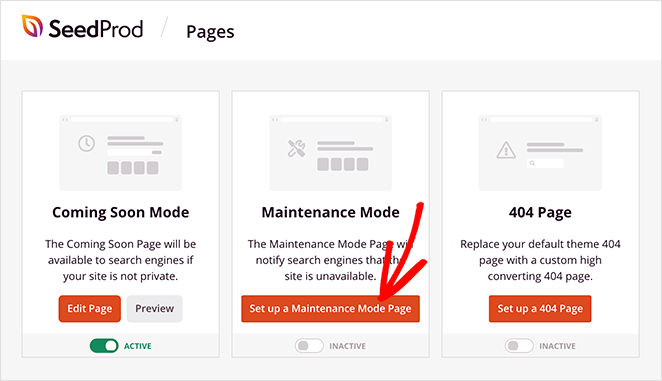
Next, SeedProd will ask you to choose a theme for your page.
Don’t worry – there are lots of themes and templates to choose from, including maintenance templates and coming soon page template options. If you want complete control over the design, you can even start with a blank template.
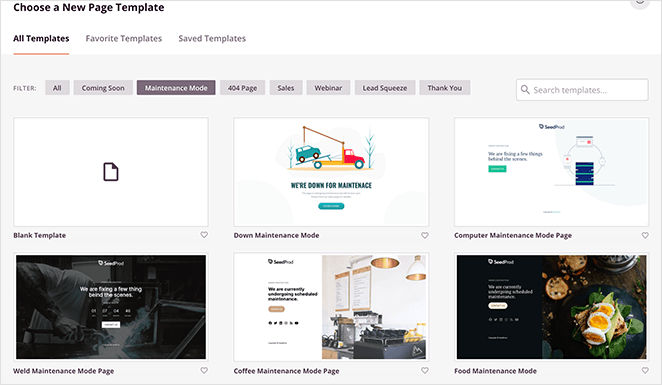
Step 4. Customize Your Maintenance Mode Page
Once you have selected a theme, you will see SeedProd’s drag-and-drop page builder. From the left-hand panel, you can drag new blocks like Image or Headline onto the preview area to customize your layout.
To change the look of the entire page, click the Global Settings gear icon in the bottom left corner. Here, you can upload your own background image or change the color scheme to match your brand style.
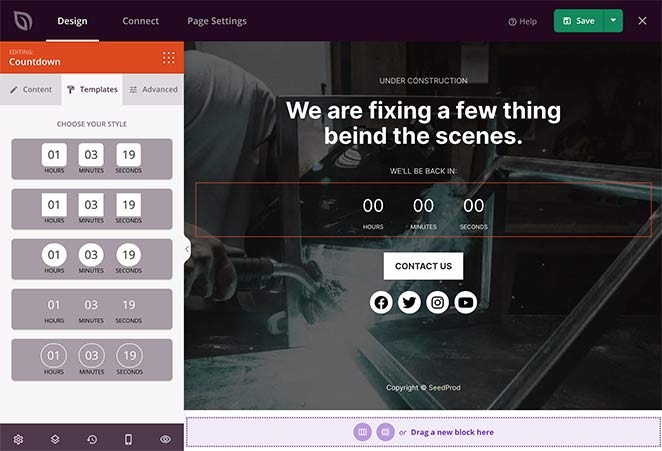
For more design ideas, you can see our guide on putting your WordPress site in Maintenance mode.
Step 5. Choose When to Show Your Maintenance Page
SeedProd lets you control when and where your maintenance page appears. Most maintenance mode plugins display one universal page, but SeedProd gives you flexible options to hide specific areas of your site.
To manage visibility, go to Page Settings » Access Control inside the SeedProd builder. Then, scroll to the Include/Exclude URLs section to choose which pages or posts to hide.
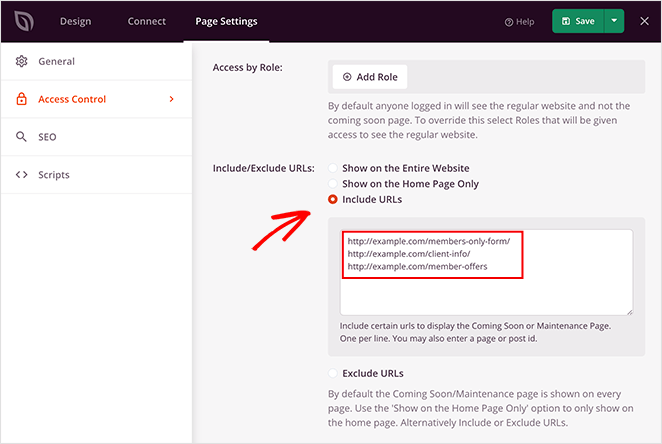
Here’s what each setting does:
- Hide Entire Website: Displays the maintenance page on every URL, blocking public access to all content.
- Show on Homepage Only: Shows the maintenance page only on your homepage while keeping other pages visible.
- Include URLs: Hides only specific pages or posts you list here, leaving everything else accessible.
- Exclude URLs: Keeps your site hidden except for the pages or posts you specify.
Allow Access to a Hidden WordPress Site
Sometimes you need to give someone access to your hidden site, like a client or collaborator. SeedProd makes this simple with secure access options.
In the Page Settings » Access Control area, you can generate a bypass URL — a special link that lets someone view your site even when maintenance mode is active. This URL includes a secret phrase that temporarily overrides the maintenance page.
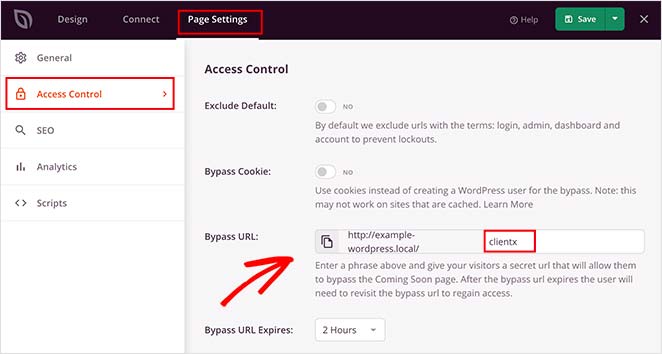
You can also add a password to your maintenance page for extra security. This lets you share private access without sending a public link.
Below that, you’ll find the Bypass by IP option. An IP address is a unique number that identifies a device on the internet. Adding a trusted IP address here allows anyone from that location to automatically view your full website.
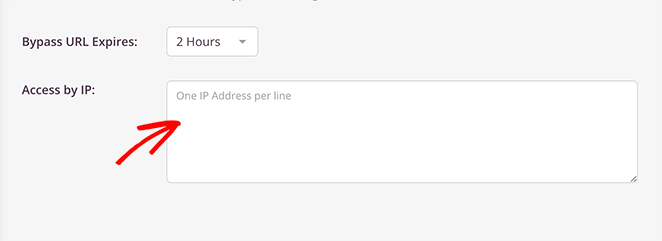
These access options are ideal for securely sharing your in-progress site with teammates, clients, or testers without removing your maintenance mode protection.
Step 6. Hide Your WordPress Website Until It’s Ready
When you’re finished designing your maintenance page, it’s time to publish it. In the SeedProd editor, click the dropdown arrow next to the Save Changes button in the top-right corner and select Publish.
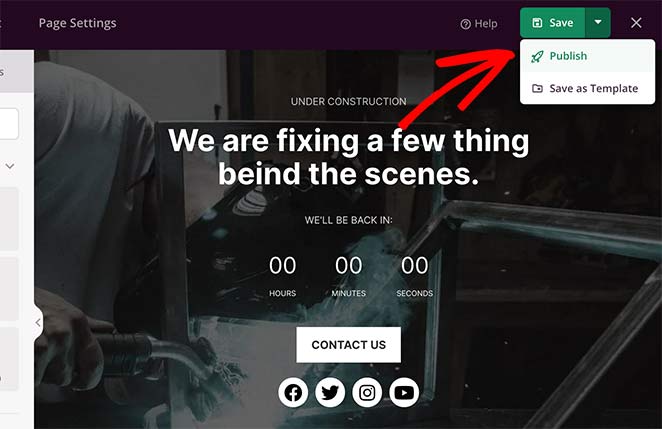
SeedProd will confirm that your page is live. You can click See Live Page to preview it on your website.

Finally, go to SeedProd » Landing Pages in your WordPress dashboard and turn the Maintenance Mode toggle from Inactive to Active.
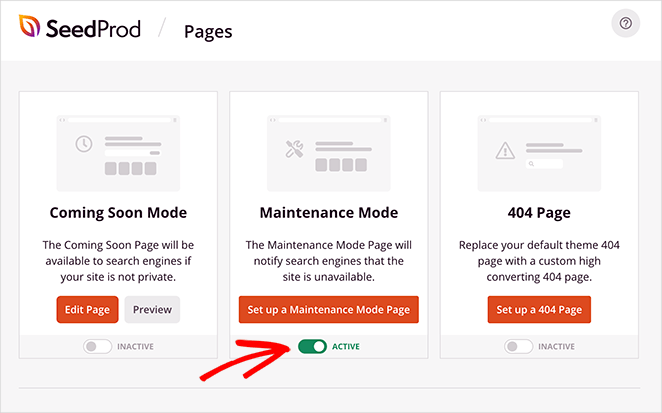
Your maintenance mode page is now active, and your website is hidden from public view until you’re ready to launch.
How to Disable Maintenance Mode
If you have followed the steps above to set up maintenance, you will eventually want to disable it when your site is ready.
To turn off WordPress maintenance mode, go to the SeedProd settings page by clicking the SeedProd icon in your WordPress dashboard.
Then, click the toggle under the Maintenance Mode section to turn it from Active to Inactive.
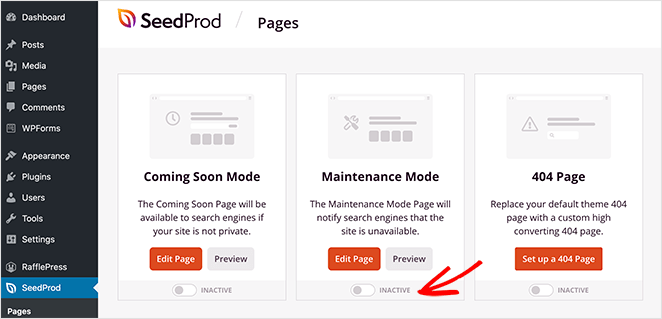
Now, your site is no longer hidden from website visitors.
What if you would rather not use a plugin to set up a maintenance page? I have instructions for that next.
How to Hide a WordPress Site Without Plugins (3 Options)
If you prefer not to use a plugin, there are still a few ways to make your WordPress site private during development. These methods are less flexible but can help keep your unfinished site out of public view.
Option 1: Use WordPress Settings to Block Search Engines
- Go to Settings » Reading in your WordPress dashboard.
- Check the box next to “Discourage search engines from indexing this site.”
- Click Save Changes.
This prevents Google and other search engines from indexing your site, but anyone with the direct link can still access it.
Option 2: Password Protect Your Site
Some hosting providers like Bluehost and SiteGround let you password protect your website through your hosting dashboard. You can also add password protection directly in WordPress using this guide: How to Password Protect a WordPress Site.
Option 3: Use a .htaccess Rule (Advanced)
If you’re comfortable editing code, you can modify your site’s .htaccess file to restrict access to everyone except your own IP address. This ensures only you can view the site while it’s under construction.
Each of these methods hides your WordPress site without plugins, but they offer limited design control and can be harder to manage than using a dedicated maintenance mode tool like SeedProd.
How to Make Individual WordPress Pages Private (Bonus Tip)
Need to hide just one page? You can use a WordPress SEO plugin like All in One SEO (AIOSEO) to control which pages appear in search results.
A WordPress SEO plugin is a tool that helps optimize your website for search engines. It lets you manage titles, descriptions, and indexing preferences directly from your dashboard.
To hide a single page, use the noindex setting. “Noindex” is a directive that tells search engines not to show that specific page in search results, even if it’s publicly accessible.
- Download and Install: Install the All in One SEO plugin from your WordPress dashboard.
- Edit a Page or Post: Go to the page or post you want to hide and click “Edit.”
- Find the AIOSEO Settings: Scroll down below the editor to the All in One SEO section.
- Enable Noindex: Check the box labeled “Noindex this page/post.”
- Publish Your Changes: Save or update the page to apply your setting.
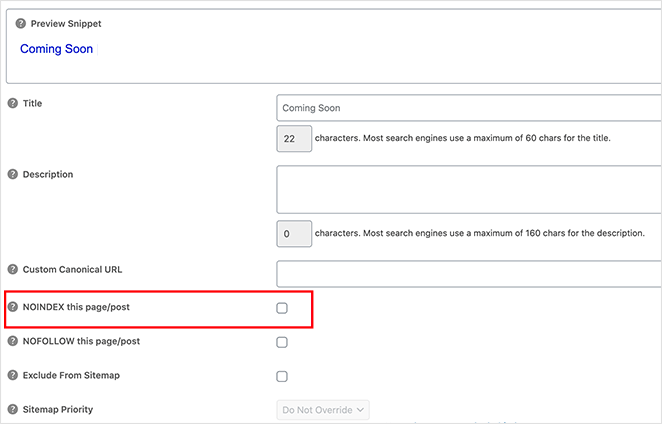
This method hides the selected page from search engines while keeping it visible to anyone who has the link, giving you precise control over what gets indexed.
Frequently Asked Questions
Get Started with Hiding Your WordPress Site
Hiding your WordPress site while you build it keeps your brand professional and your visitors curious. Using a maintenance mode plugin gives you complete control over who can view your site and what they see during development.
Whether you’re launching a new project or updating an existing website, SeedProd makes it simple to stay private while you work. Its drag-and-drop builder, customizable templates, and access controls let you focus on design and content without exposing unfinished pages.
Ready to protect your site and launch with confidence? Get SeedProd today and start building your website in private until it’s ready to go live.
I hope you found this guide helpful. If you’re interested in more helpful WordPress tutorials, check these out:
- How to Make a Sales Page With WordPress (Step-by-Step)
- How to Create a Coming Soon Page in WordPress.
- 6+ Best Photo Gallery WordPress Plugins (Expert Pick)
- How to Customize WordPress Post Excerpts (Without Code)
Thanks for reading! We’d love to hear your thoughts, so please feel free to join the conversation on YouTube, X and Facebook for more helpful advice and content to grow your business.

